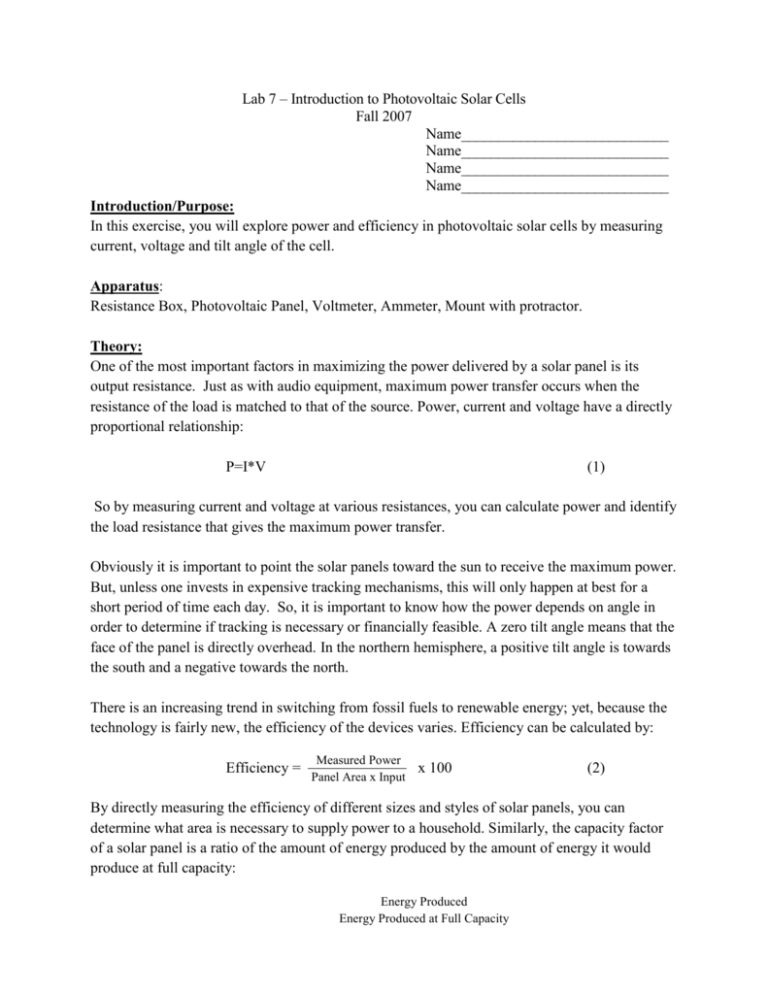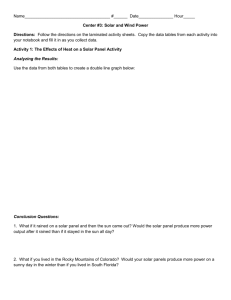Photovoltaics I
advertisement

Lab 7 – Introduction to Photovoltaic Solar Cells Fall 2007 Name____________________________ Name____________________________ Name____________________________ Name____________________________ Introduction/Purpose: In this exercise, you will explore power and efficiency in photovoltaic solar cells by measuring current, voltage and tilt angle of the cell. Apparatus: Resistance Box, Photovoltaic Panel, Voltmeter, Ammeter, Mount with protractor. Theory: One of the most important factors in maximizing the power delivered by a solar panel is its output resistance. Just as with audio equipment, maximum power transfer occurs when the resistance of the load is matched to that of the source. Power, current and voltage have a directly proportional relationship: P=I*V (1) So by measuring current and voltage at various resistances, you can calculate power and identify the load resistance that gives the maximum power transfer. Obviously it is important to point the solar panels toward the sun to receive the maximum power. But, unless one invests in expensive tracking mechanisms, this will only happen at best for a short period of time each day. So, it is important to know how the power depends on angle in order to determine if tracking is necessary or financially feasible. A zero tilt angle means that the face of the panel is directly overhead. In the northern hemisphere, a positive tilt angle is towards the south and a negative towards the north. There is an increasing trend in switching from fossil fuels to renewable energy; yet, because the technology is fairly new, the efficiency of the devices varies. Efficiency can be calculated by: Efficiency = Measured Power Panel Area x Input x 100 (2) By directly measuring the efficiency of different sizes and styles of solar panels, you can determine what area is necessary to supply power to a household. Similarly, the capacity factor of a solar panel is a ratio of the amount of energy produced by the amount of energy it would produce at full capacity: Energy Produced Energy Produced at Full Capacity Capacity Factor = x 100 (3) Procedure: Optimizing Power: 1. Wire the circuit according to Figure 1. a. The load is the decade resistance box (or, for large panels, another variable resistor). b. Be sure to set the resistance to 1000Ω. Have the instructor check your wiring if you do not have reasonable current and voltage measurements. Load Solar Panel Figure 1: Circuit with voltmeter, ammeter, load and solar panel 2. Turn down the resistance and measure the current and voltage as a function of resistance. 3. Calculate the power and plot power verse resistance (this is a good place to use Excel because it can do the multiplication for you, as well as drawing the graph) 4. Determine the resistance for which the output power has a maximum. Testing Angular Dependence: 1. Set up your solar panel, voltmeter, ammeter and load according to Figure 1 2. Obtain a mount with protractor and place the solar panel on the mount. 3. Align the solar panel in the north/south direction so that when it is tilted properly, it points directly at the sun. 4. Use the resistance, that you found earlier, that gives maximum power. 5. Measure the output power as a function of angle from the horizon. 6. Plot the power versus the angle and determine the angle that gives the maximum power output. Are you surprised? Testing Efficiency: 1. Set the solar panel at the angle of maximum output and the decade resistance box to the resistance that gives the maximum. 2. Measure the current and voltage and calculate the power. How does this value compare to the rated power output? How large would your solar panel need to be to produce 2 kW? Is this reasonable? 3. Measure the length and width of the solar panel and compute the area. If the intensity of the solar radiation is 67 W/m2 (the 10-year average for Minneapolis), how much power is absorbed by the solar panel assuming reflection is negligible? 4. Calculate efficiency of the solar panel. Testing Power Output for a Fixed System: 1. Record the power output of the solar panel as a function of time for the whole day (or use data supplied by your instructor). 2. Graph power versus time. 3. Estimate the total energy (in kWh) available from this panel for one sunny day. 4. Use this number to calculate the annual energy output if you assume 365 sunny days in a year. What if you use the average number of sunny days for St. Peter (or Minneapolis)? What is the estimated annual energy output then? 5. Calculate the maximum theoretical annual output value by using the rated output of the panel and the total number of hours in a year. 6. Calculate the capacity factor for this panel in this location. How does this compare to a capacity factor of approximately 30% for wind turbines in Minnesota?





